From meerkats to lions and everything in between, roadtripping and camping in southern Africa is next-level. Constantly changing landscapes, waking up at sunrise in a roof-top tent, chilly mornings and evenings with baking heat in between, boerewors on the braai. The freedom that roadtripping brings, and the endless possibility for adventure that comes naturally with travelling in Africa. What could be better than combining all that in a roadtrip from South Africa to Namibia and Botswana?
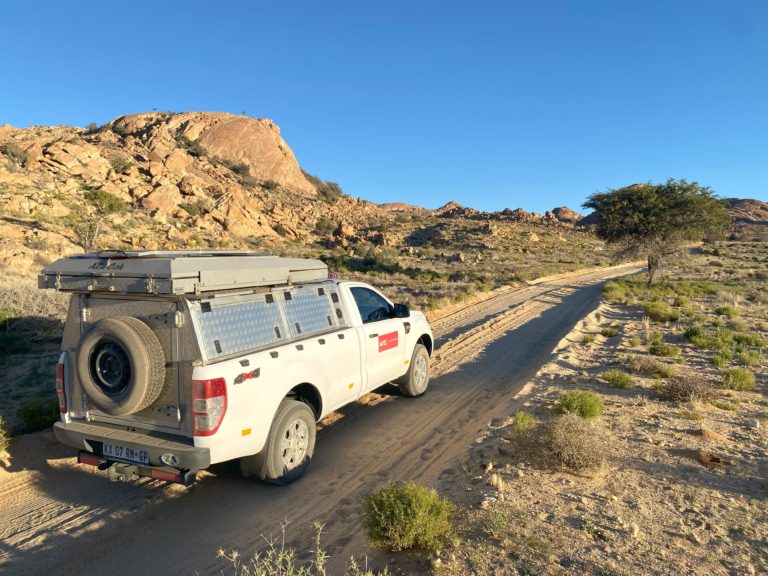
A self-driving safari in southern Africa is definitely one of the world’s ultimate roadtrips. Thinking about taking it on? In this post I’ve outlined our twenty-one day self-driving itinerary, and provided some information to help you plan your own ultimate African roadtrip:
Self-driving
On the road: our itinerary
Before you go: planning your trip
Maun, and moving on
In case you’re wondering what you’ll find along the way, I’ve written another post about the very best of what we saw and did. Check it out here: Home is where the car is: a roadtrip in southern Africa.
Self-driving
We’ve taken on large swaths of Africa by public transport and that is no small feat – just have a look at the trips on this blog. But we decided to hire our own car and self-drive in southern Africa. The route we planned would have been impossible with public transport. You can’t get properly into the parks, distances are vast, buses only run between bigger cities, etc. On the limited public transport options available you’d miss out on the experiences that truly make this trip incredible.
Also keep in mind, that when you drive yourself on a trip like this (assuming there are two of you): one person is driving and the other is the animal spotter and photographer. Actually, both of you should be keeping an eagle-eye out for animals bounding around into the road. We’ve safaried by now in pretty much every category possible, and definitely the upside to going with a guide is that you have someone who knows where to look for the animals, and can answer all your questions. An sometimes they’ll even make you sundowners on the savannah.
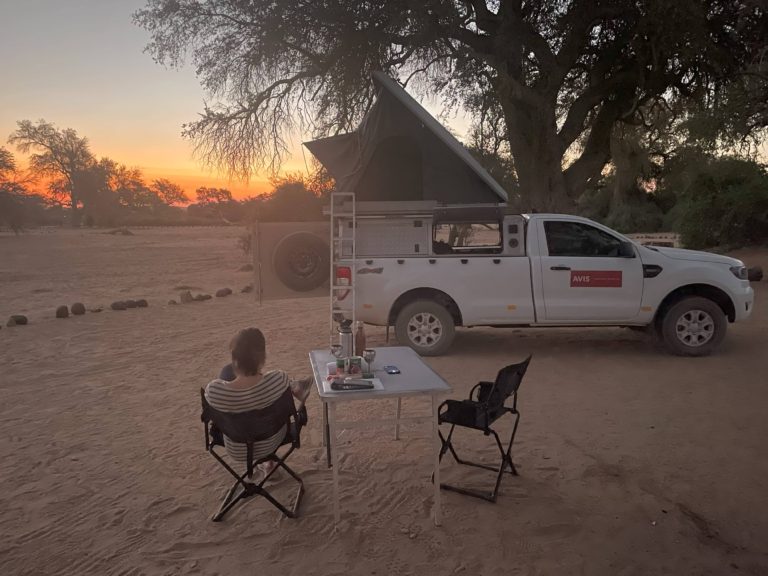
Self-driving is the most expensive way to get around but you have all the freedom to plan the route yourself. If you decide to hire a car and self-drive southern Africa, here are some things to think about:
- Finding a car. There are a many resources for car hire available. Google is your friend:) We shopped around and chose the quote from DriveSouthAfrica. The price will vary depending on the season. Although you can do parts of this trip with a regular 2WD, you’re much better off hiring a 4WD. A lot of areas will otherwise be inaccessible to you, especially in Botswana.
- Pick-up and drop-off. You can start and end your trip in two different cities or even in two different countries. We picked up in Johannesburg (South Africa) and dropped off in Maun (Botswana). This worked really well for us, and it’s one of the reasons you’ll want to plan your route before finalizing the car.
- Collecting the car. Check it over really carefully in daylight, inside and out, before you sign off and pay up front. Get familiar with all the documents in the glove compartment – these are permits and a passport for the car, which you’ll need at checkpoints and at the borders when you take it across.
- Insurance. The car company should cover all cost up to a deductible as long as you don’t get stuck in the sand on the beach in Namibia as the tide comes in, or hit an elephant (or almost any large animal).
- Kilometers. The distances especially in Namibia are humongous so make sure you have unlimited kilometers.
- Fuel. We topped up the tank whenever fuel was available and tried to stay as close to full as possible.
- Road conditions and traffic (animals). The roads vary constantly from different depths of sand, to loose gravel, to smooth pavement, and so on, but are often a lot better than you think. Traffic isn’t really an issue other than driving in/out of the big cities. We could drive for hours without seeing another vehicle in Namibia. In some places more than others, you really need to keep your eyes peeled for animals. Don’t drive at night.
- Security. Crime is an issue in South Africa, not only in Johannesburg and Cape Town. It is important to be vigilant when stopping at gas stations and grocery shops. Keep your doors locked when driving. Namibia and Botswana are much safer, but even there we had more than one person warn us to be careful, watch out, etc.
- Driving. Last but certainly not least, consider your driving skills. You’ll be driving on sandy roads especially in Botswana’s national parks, and probably off-roading too. Depending on the time of year, you may get all sorts of weather.
- Food. You can’t bring uncooked meat over the borders.
- The Maps.me app has the best off-road maps. We were told by locals to use Maps.me not Tracks 4 Africa.
On the road: our itinerary
This post is about our experience roadtripping from Johannesburg to Maun in three weeks, but you can certainly adapt any part of our itinerary to suit yourself. We’re just trying to help you get started:)
DAY 1 – Johannesburg to Kuruman (South Africa)
DAY 2 – Kuruman to Kgalagadi Transfrontier Park
DAY 3 – Transfrontier Park – Twee Rivieren camp to Mata-Mata camp
DAY 4 – Transfrontier Park (Mata Mata camp) to Aus (Namibia)
DAY 5 – Aus to Sesriem (detour to Luderitz/Kolmanskop)
DAY 6 – Sesriem (daytrip to Soussusvlei/Deadvlei)
DAY 7 – Sesriem to Swakopmund
DAY 8 – Swakopmund (rest day)
DAY 9 – Swakopmund to Brandberg (detour to Cape Cross)
DAY 10 – Brandberg to Etosha National Park
DAY 11 – Etosha National Park
DAY 12 – Etosha National Park
DAY 13 – Etosha National Park to Caprivi Strip
DAY 14 – Caprivi Strip (rest day)
DAY 15 – Caprivi Strip to Kavimba (Botswana. Detour to Kasane)
DAY 16 – Chobe National Park – Riverfront
DAY 17 – Kavimba to Chobe National Park
DAY 18 – Chobe National Park – Linyanti
DAY 19 – Chobe National Park – Linyanti to Khwai
DAY 20 – Khwai
DAY 21 – Khwai to Maun
All the driving times here include our stops to grocery shop, look around, take photos, walk, sight-see, make coffee, or eat lunch.
DAY 1 – Johannesburg to Kuruman (South Africa)
Departed Johannesburg: 11 am
Arrived Kuruman: 6 pm
It’s about 530 kilometers from Johannesburg to Kuruman. The drive is mostly highway and sometimes country roads through flat farmland. Since we had done most of our grocery shopping before we picked the car up, we only had to grab a few of the fresh items in Kuruman. We didn’t want to overstock on meat, since in a couple of days we’d be crossing a border and it could be confiscated.
Roads: sealed, in good condition.
Time: 7.5 hours
Kilometers: 530
Accommodation: powered campsite at Red Sands Country Lodge
DAY 2 – Kuruman to Kgalagadi Transfrontier Park
Departed Red Sands Country Lodge: 9 am
Arrived Kgalagadi Transfrontier Park, Twee Rivieren campground: 4 pm
This stretch was mainly just a driving day to reach the park. There is nothing much to see but we made a nice lunch stop in Askham at the Diamond T Coffee Shop.
We had planned to spend only one night in the Transfrontier park before crossing the border to Namibia. However, at the park office we learned that it’s mandatory to stay at least two nights if you want to exit South Africa from the border post inside the park. So at this point we booked the next night at Mata Mata campsite, which is inside the park and next to the Namibian border post.
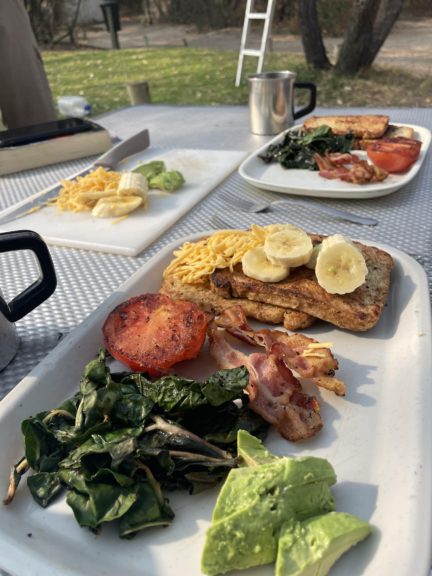
We had originally booked the next night at Quiver Tree Forest Camp in Namibia, so we had to cancel that.
Roads: sealed, in good condition. After entering the park the road became sandy but not deep sand.
Time: 7 hours
Kilometers: 515
Accommodation: powered campsite at Twee Rivieren campground
DAY 3 – Transfrontier Park – Twee Rivieren camp to Mata Mata camp
Departed Twee Rivieren: 8 am
Arrived Mata Mata: 2 pm
First things first. There is a petrol station at the Twee Rivieren campground where you can deflate your tires before driving on the sandy park roads. Ask the staff about upcoming road conditions and adjust the tire pressure accordingly. We learned this the hard way. We got a flat tire on the way from Aus to Sesriem due to not setting the pressure correctly.
We spent the day game-driving slowly towards Mata Mata. The landscape is unique and beautiful.
Roads: light sandy roads at this time of year.
Time: 5.5 hours
Kilometers (not including short detours): 105
Accommodation: powered campsite at Mata Mata camp
DAY 4 – Transfrontier Park (Mata Mata camp) to Aus (Namibia)
Departed Mata Mata camp: 8 am
Arrived Aus: 4 pm
The border crossing inside the park is pretty straightforward. You’ll pay a small fee for road tax. The drive on the Namibian side towards Aus is on ever-changing and beautiful hilly red roads until Keetmanskop. Just before Keetmanskop is the Quiver Tree Forest which you can stop off at to take a look.
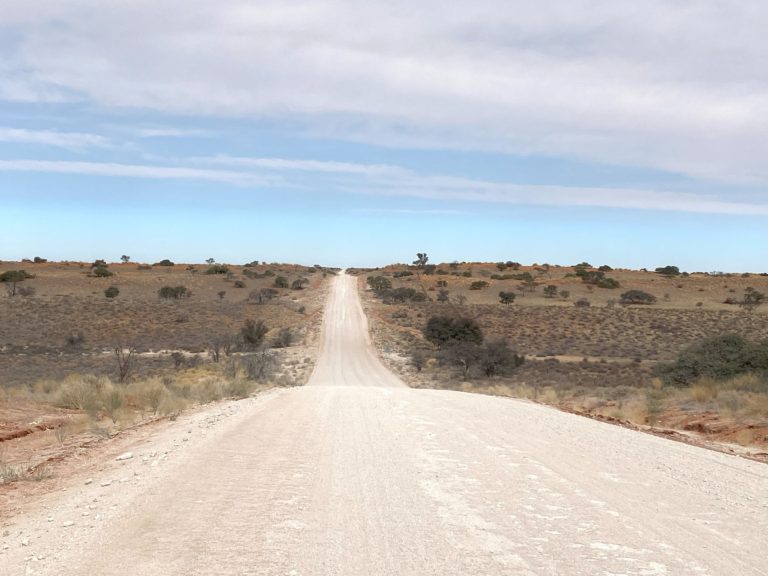
Roads: gravel from the border to Keetmanskop. The rest of the way to Aus is asphalt.
Time: 8 hours
Kilometers (not including detours): 475
Accommodation: powered campsite at Klein Aus Vista
DAY 5 – Aus to Sesriem (detour to Luderitz/Kolmanskop)
Departed Aus: 7 am
Arrived Sesriem: 5.30 pm
We set off early in the morning to have a coffee in Luderitz, about an hour away. There are a few good cafes in Luderitz – we picked the Desert Deli. We went to Luderitz in the first place to check out Kolmanskop, the mining ‘ghost town’ nearby. Check the tour times in advance, you can go in by yourself but the tour is good. You can pay for it online or at the gate – bring cash, paying by card is unreliable.
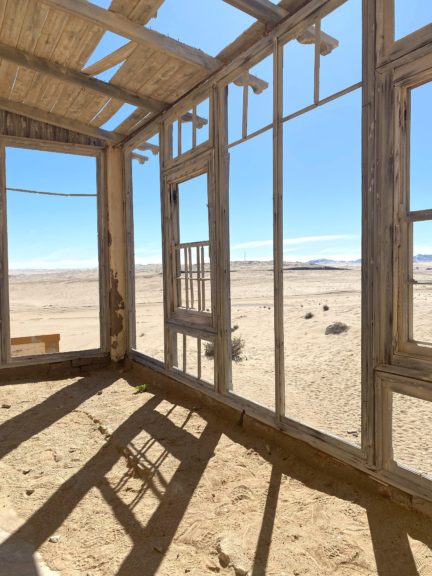
Can’t stress this enough – check and adjust your tire pressure before driving on to Sesriem. We didn’t and ended up with a flat right before Helmingerhausen. Helmeringhusen on the other hand does have a nice cafe and very helpful staff at a garage.
Roads: sealed from Aus to Luderitz. From Aus to Sesriem is gravel but in pretty good condition.
Time: 10.5 hours
Kilometers: 636 km
Accommodation: powered campsite at Little Soussus Lodge
DAY 6 – Sesriem (daytrip to Soussusvlei/Deadvlei)
Departed campsite: 8 am
Arrived campsite: 4 pm
Little Sossus Lodge is a great spot to camp. Each site has sheltered parking for the car and a little kitchen and bathroom setup.
There will be a queue at the Sesriem gate in the morning. Try to be early, and remember sunscreen (we did not and had to buy some at the garage in Sesriem, you need it). You will get a permit at the park gate. You can pay the ticket when you leave the park, to save time and beat the crowds.
Again: ask at your accommodation or a service station about road conditions on the way to and around Sossusvlei and Deadvlei. Adjust your tire pressure. Once you’re inside the gate drive to the end of the sand river. There’s a car park where you can leave the car to explore Deadvlei (1 on map below). You can climb up (and run down) various huge dunes, and of course see the famous petrified camelthorn trees in Deadvlei. There are also plenty of areas you can set up in the shade and cook or have a picnic at Sossusvlei (2). We climbed Dune 45 (3).
Don’t get stuck!! If you’re not driving a 4×4 you can leave your car in the car park and get a ride out to the dunes on a wagon pulled by the tractor. Our campground gave us this map, they also advised us about driving conditions, and so on:
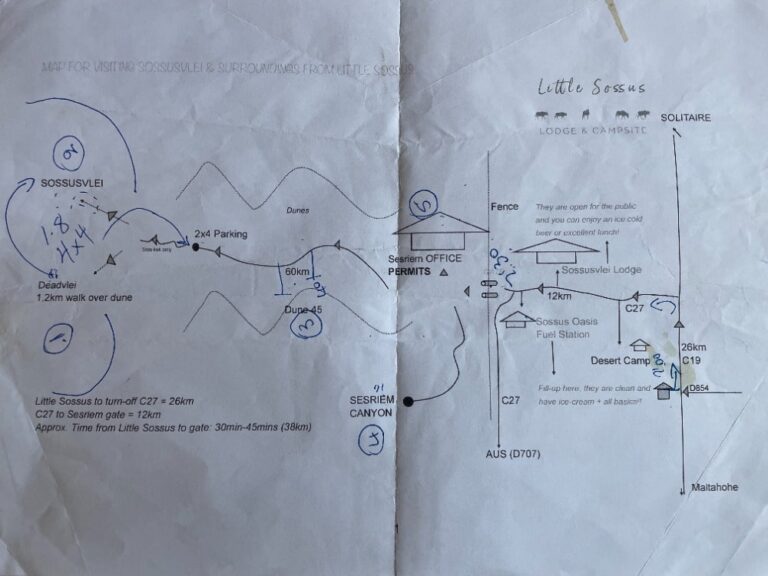
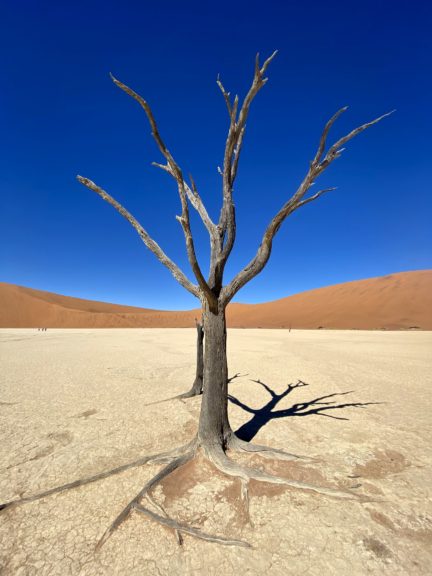
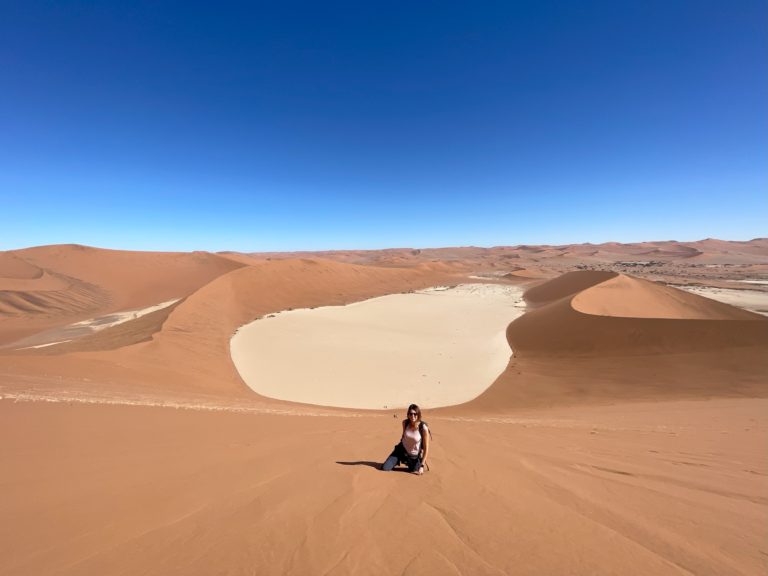
Roads: sealed until you get to the sand river. Keep up your speed in the sand, never stop or you’ll get stuck.
Time: 8 hours
Kilometers: 220
Accommodation: powered campsite at Little Sossus Lodge
DAY 7 – Sesriem to Swakopmund
Departed Sesriem: 8 am
Arrived Swakopmund: 2 pm
The landscape changes constantly which makes for an interesting drive. Like literally every single other person there, we stopped at McGregor’s Bakery in Solitare, for their ‘famous apple pie’. It’s ok, but for us the point of the stop was just that we needed lunch.
After Solitare we made a left towards Swakopmund. On the way you’ll pass the sign for the Tropic of Capricorn. After the sign we carried on through Gaub Pass, and the landscape changed again.
There are tons of places to stay in Swakopmund but we opted to stay at a campground just bit removed from the city. No big deal when you’ve got your own wheels anyway.
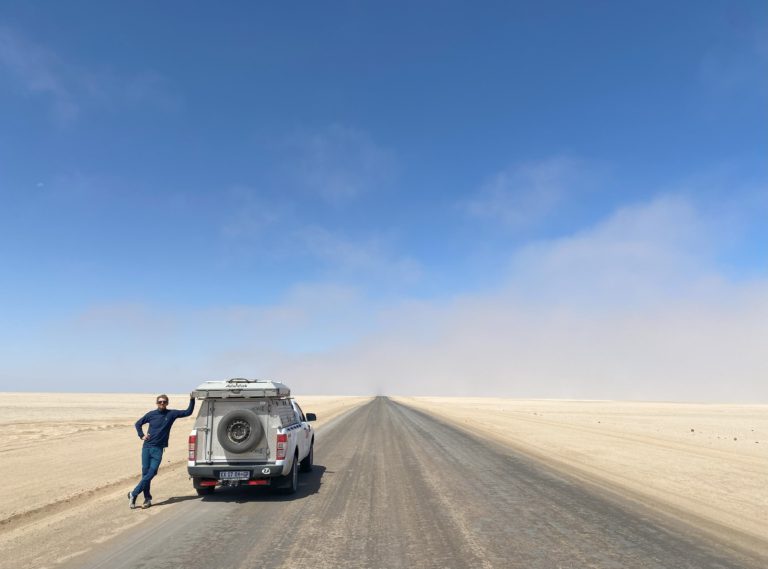
Roads: unsealed until just outside Swakopmund, but pretty good.
Time: 6 hours
Kilometers: 350
Accommodation: powered campsite at Sophia Dale Base Camp
DAY 8 – Swakopmund (rest day)
After seven days of braaing and cooking we decided to just chill in the cafes and restaurants in Swakopmund. We sampled the German cooking at Swakopmund Brauhouse, and there’s excellent pizza at Gabriele’s Italian Pizzeria.
Accommodation: powered campsite at Sophia Dale Base Camp
DAY 9 – Swakopmund to Brandberg (detour to Cape Cross)
Departed Swakopmund: 8 am
Arrived Brandberg: 3 pm
On way up the coast to Cape Cross we were hoping to see some old shipwrecks but the fog was too thick that morning. The drive to the Cape Cross Seal Colony took around 1.5 hours. It’s a great but fairly smelly expreience – definitely worth a short detour. After the colony we backtracked to the T-junction right before Hentiesbaai and headed towards the Brandberg mountains.
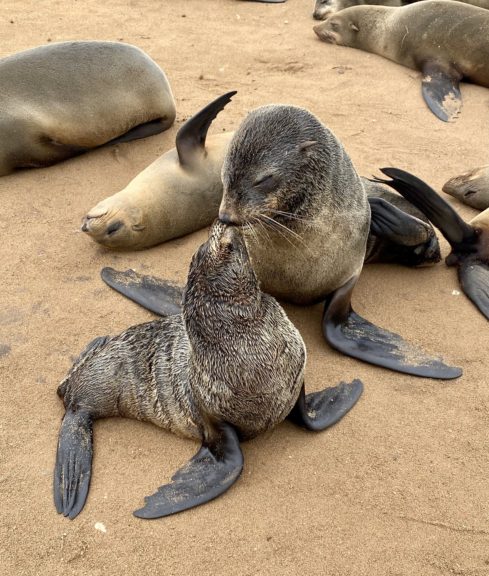
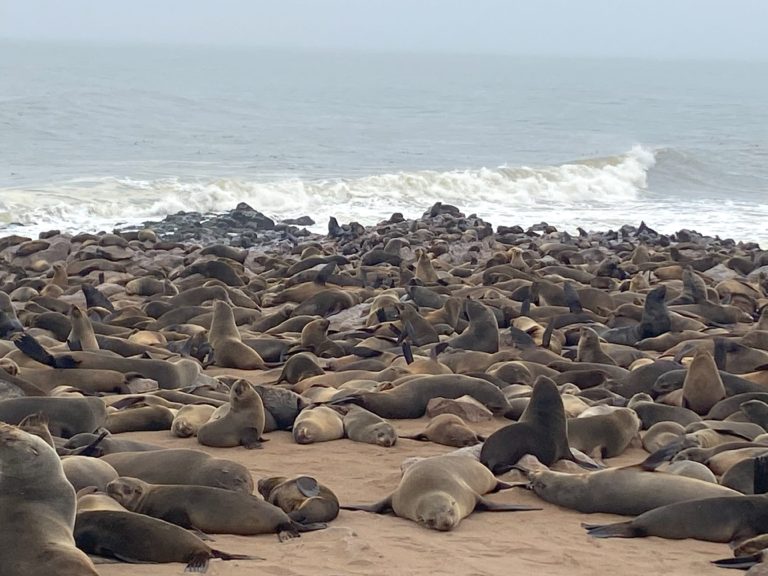
We absolutely loved our campsite at the White Lady Lodge in Brandberg. If you’re lucky you might get elephants walking right through your campsite. The lodge has a pool which campers can also use.
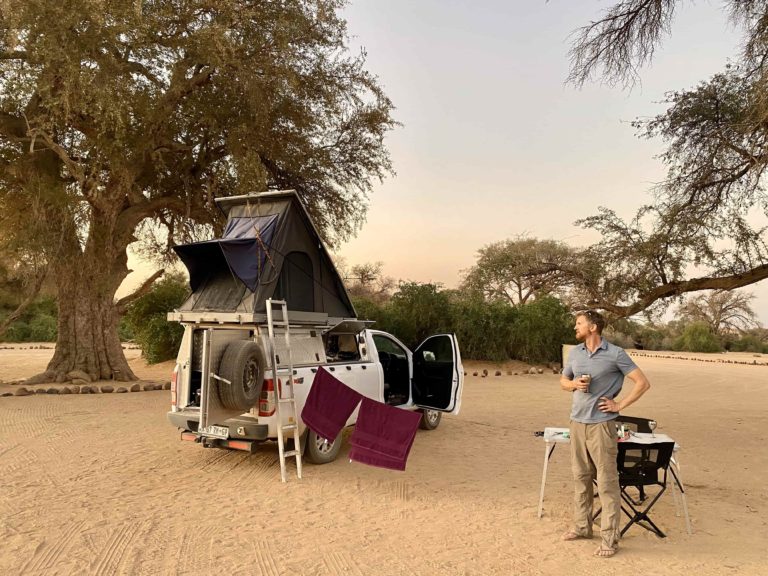
Roads: unsealed until sometime after the T-junction in Hentiesbaai. It was under improvements at the time.
Time: 7 hours
Kilometers: 330
Accommodation: unpowered campsite at Brandberg White Lady Lodge
DAY 10 – Brandberg to Etosha National Park
Departed Brandberg: 9 am
Arrived Etosha Trading Post: 4 pm
This day was mostly just a driving day to reach Etosha National Park. We stopped in Outjo we stocked up on fuel, groceries, and wine. You can buy stuff in Etosha but everything is more expensive and grocery selection is more limited.
We decided to stay just outside the park on the first night, at Etosha Trading Post campground. That was a great decision since the campsite at Okaukuejo is very busy and crowded. The Trading Post is right next to the park has waterhole which is lit up at night. It’s small and the sites are awesome – besides the usual braai and tap you get a little kitchen area and your own open-air bathroom.
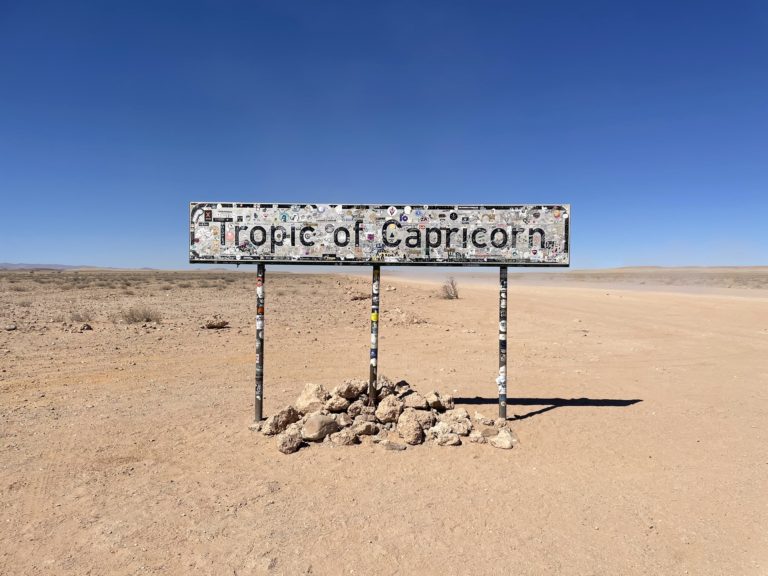
Roads: unsealed until Khorixas. The rest of the way to Etosha is sealed.
Time: 7 hours
Kilometers: 350
Accommodation: powered campsite at Etosha Trading Post
DAY 11 – Etosha National Park
We entered the park at Andersson gate and went straight to the main office there to pay park fees and sort out the campsites. Then we headed out for some game-driving.
We spent one night at Okaukuejo camp. It’s the biggest one and has a distinct parking-lot feel to it. It’s busy and ugly and has an extremely non-atmospheric restaurant. But, they have a big waterhole which is floodlit at night and this was busy with elephants and rhinos and made the stay worthwhile. I’d actually recommend it just for the waterhole. It’s convenient as well since it’s just inside the gate but otherwise if you’re exploring that side of the park I’d stay outside, at Etosha Trading Post for example.
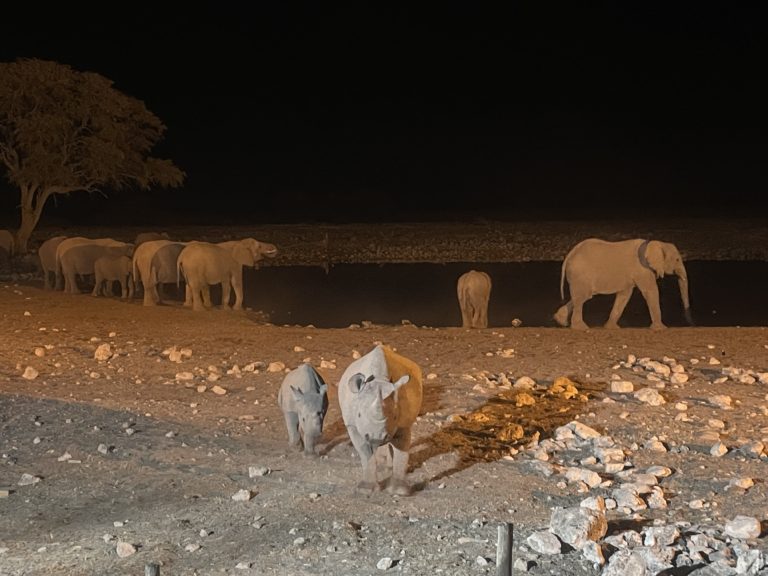
Roads: unsealed but in good condition when we were there in the dry season.
Accommodation: powered campsite at Okaukuejo camp
DAY 12 – Etosha National Park
Departed Okaukuejo camp: 8 am
Arrived Namutomi camp: 1 pm
We made our way slowly game-driving from Okaukuejo camp to Namutoni camp. Namutoni is a more peaceful and less crowded and much better than Okaukuejo. They also have a waterhole but it was not as busy as Okaukuejo.
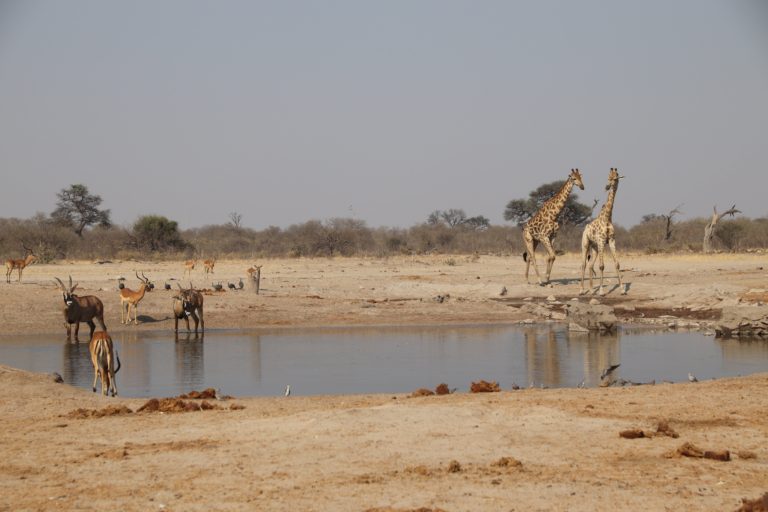
Roads: unsealed but in good condition when we were there in the dry season.
Time: depends on game-driving
Kilometers: 135
Accommodation: powered campsite at Namutoni camp
DAY 13 – Etosha National Park to Caprivi Strip
Departed Namutoni camp: 8 am
Arrived Caprivi Strip: 4-5 pm
We exited the park at Von Lindequist gate. This was mainly a driving day with nothing particular to see or do along the way – just enjoying the road and listening to audio books. We made stops for groceries and petrol in Grootfontein. Again, we were careful not to overstock meat since we had the border crossing to Botswana coming up soon and meat can be confiscated.
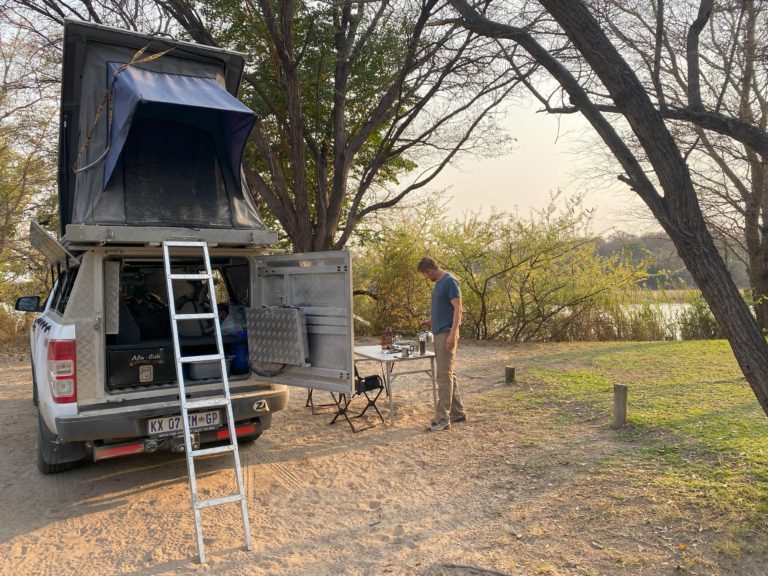
Roads: sealed and in good condition. The 3 km from the main road to Ngepi campsite is a sand track, but it is possible to drive there in a 2WD.
Time: 8-9 hours
Kilometers: 640
Accommodation: powered site at Ngepi camp
DAY 14 – Caprivi Strip (rest day)
Ngepi campground along the Okavanga river is beautiful and peaceful. Sites are big and private with lots of shade, strung out along a dirt road. You can see wildlife on the other side of the river, elephants, rhinos, warthogs, buffalo and so on. We just hung out there for a day enjoying the peace and quiet. They have a nice lodge area too if you don’t want to cook and – they have a wood fired bath on a little platform overlooking the river. Especially if you haven’t had one recently – take a bath!
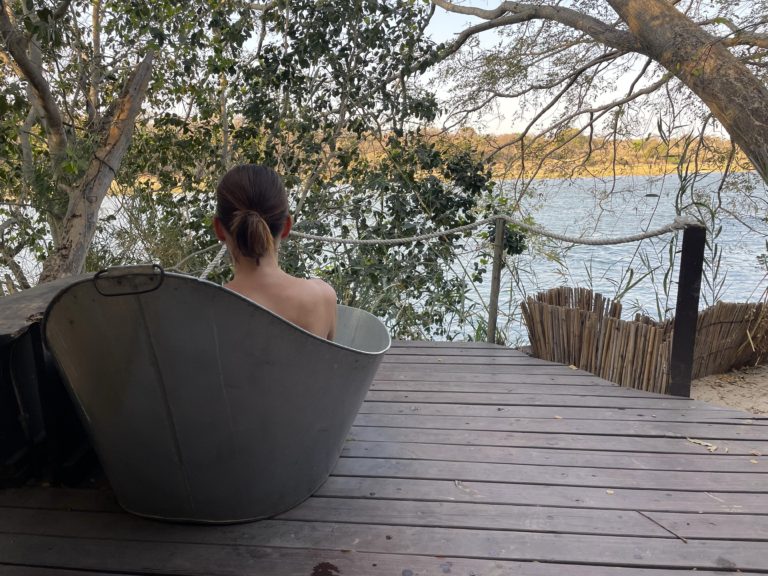
Roads: sand track from Ngepi campground to the main road.
Accommodation: powered campsite at Ngepi campground
DAY 15 – Caprivi Strip to Kavimba (Botswana. Detour to Kasane)
Departed Caprivi Strip: 9 am
Arrived Kavimba: 2 pm
To be on the safe side we wanted to carry a satellite phone with us in the Chobe/Okavanga area. Up until Botswana we weren’t worried about getting stranded roadside or stuck in the sand, but in Chobe/Okavanga you can drive into pretty isolated and remote areas, and on deep sand roads that could be difficult to handle the car on, especially depending on your level of expertise. Theoretically, in low season a few days could go by before you see another vehicle. So, we reserved a phone in advance with a Sat4Rent company (the place we hired the car from recommended them) and arranged to pick it up in Kasane. There was really no other reason to go to Kasane at this point besides picking up a phone, getting cash, or stocking up on groceries.
The border crossing between Namibia and Botswana is straightforward. On the Namibian side we showed the car papers and stamped out. Then we drove across the bridge over the Okavanga river and got our first glimpse of why Botswana is such an amazing safari destination…there are animals everywhere along the river. Before driving up the small hill on the Botswanian side, we drove through a shallow pool of disinfectant – there’s hoof and mouth in Namibia yet somehow they are keeping it out of Botswana. Before we got our Botswana entry stamps we also had to step into some disinfectant to clean our shoes.
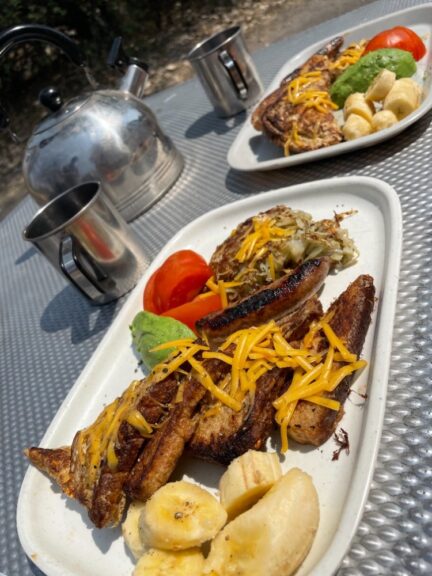
Roads: sealed, in good condition
Time: 5 hours
Kilometers: 285 (detour to Kasane)
Accommodation: powered campsite at Mwandi View camp
DAY 16 – Chobe National Park – Riverfront
If you’re planning your trip early enough and can get into the Chobe Riverfront – Ihaha campsite, definitely do that. We ‘only’ booked 4-5 months in advance, and even then pickings were slim for campsites in Chobe and Okavanga – meaning we had to find alternate camps and in some cases juggle days around or change the itinerary to work with what was still available.
In Kavimba we stayed at Mwandi View, which has a pretty view over the Cuando river and its own waterhole. The owner there is really knowledgeable and very helpful with planning our game-drives. He pointed out that it’s better to enter the Riverfront from the northern end than from the very busy southern end near Kasane. Coming from Kasane you get all the crowds of daytrippers from both Kasane and Zambia.
Staying at Mwandi View, we went for both morning and evening drives on the Chobe Riverfront.
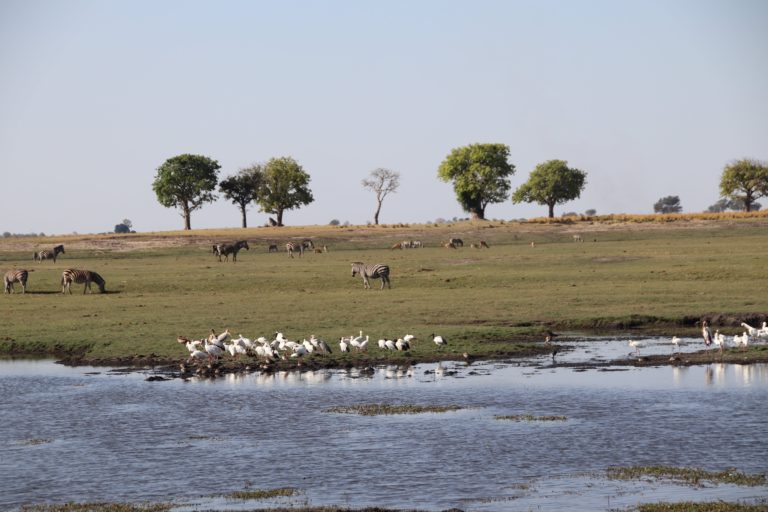
Roads: sand and dirt, in pretty good condition in Chobe Riverfront
Time: depends on game-driving
Accommodation: powered campsite at Mwandi View camp
DAY 17 – Kavimba to Chobe National Park
Departed Kavimba: 8 am
Arrived Linyanti: 11 am
After some more useful information from our host regarding the road ahead, we set off to tackle the sand tracks to Linyanti camp in Chobe. In August the road was very sandy and we kept up a good pace to avoid getting stuck. Often the sand was so deep that we could feel the traction underneath the car and thought we were stuck for sure, but it never happened!
Eventually we reached the Linyanti gate where we paid our park fees (we’d already paid for the campsite).
Originally we’d wanted to break up the drive by spending a night in Savuti campsite, which is about halfway to our next campsite at Khwai. Savuti was fully booked so we took two nights at Linyanti instead, and did not regret it. It was amazing. Our site was right on a marshy riverbank and there were herds of elephants all around.
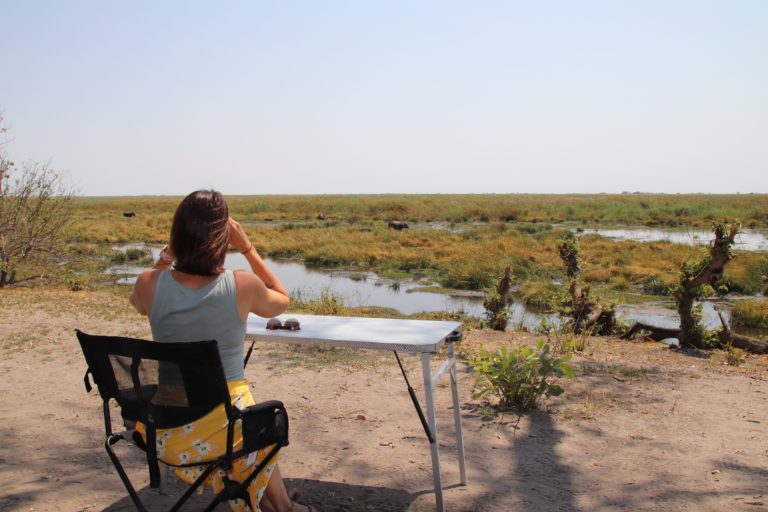
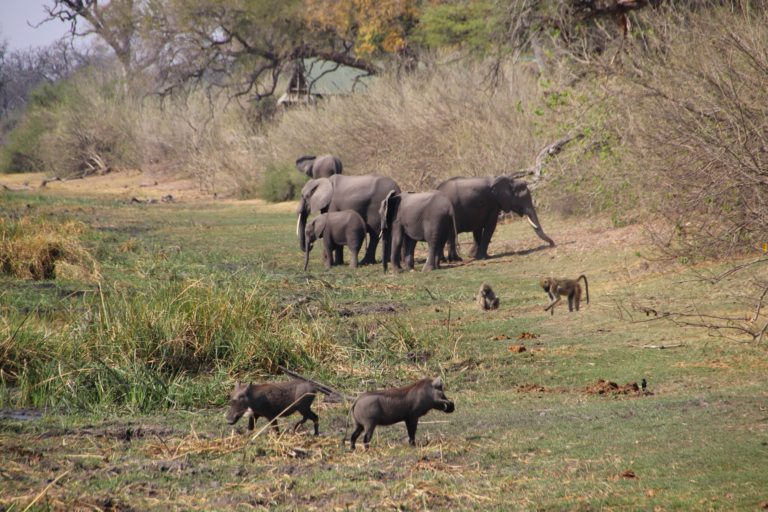
Roads: deep sand after Kavimba town.
Time: 2.5-3 hours
Kilometers: 95
Accommodation: unpowered campsite at Linyanti camp
DAY 18 – Chobe National Park – Linyanti
We absolutely loved our time at Linyanti. We spent the morning and evening game driving, but the main draw for this camp was the elephants along the riverfront right next to our site. We mainly spent two days watching the elephants roaming right past us to and from the water. And we woke up one night to an elephant snacking on a tree next to our car.
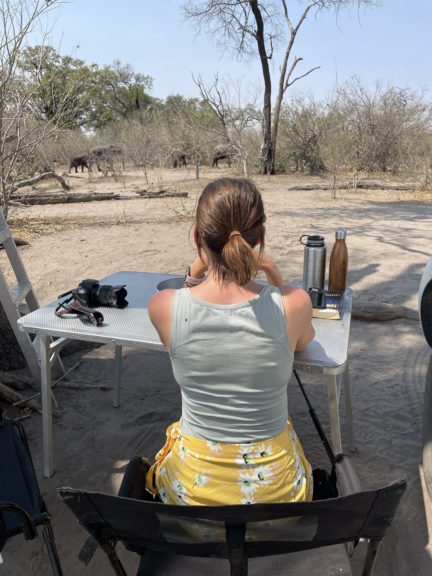
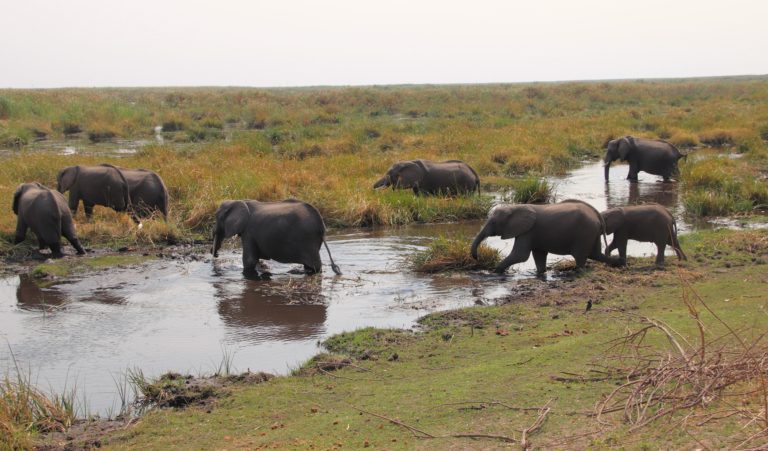
Roads: sandy (but not very deep sand) inside Linyanti gate.
Accommodation: unpowered campsite at Linyanti camp
DAY 19 – Chobe National Park – Linyanti to Khwai
Departed Linayanti: 7.30 am
Arrived Khwai: 3 pm
We were a bit worried about this day since it was a long drive though deep sand, but it went better than we thought. We’d been warned numerous times not to drive the direct route from Linyanti to Savuti which is mapped on Maps.me, but instead to go back the way we came and continue from there to Ghoha gate. The road was deep sand all the way to Ghoha gate in August, but after Ghoha gate it was pretty smooth sailing to Savuti. After Savuti we followed directions to go left at Elephant rock heading towards Mababe gate, for a better chance of seeing animals.
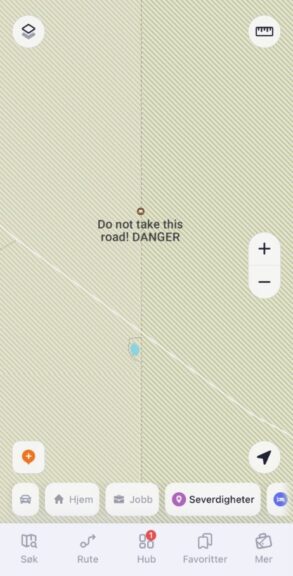
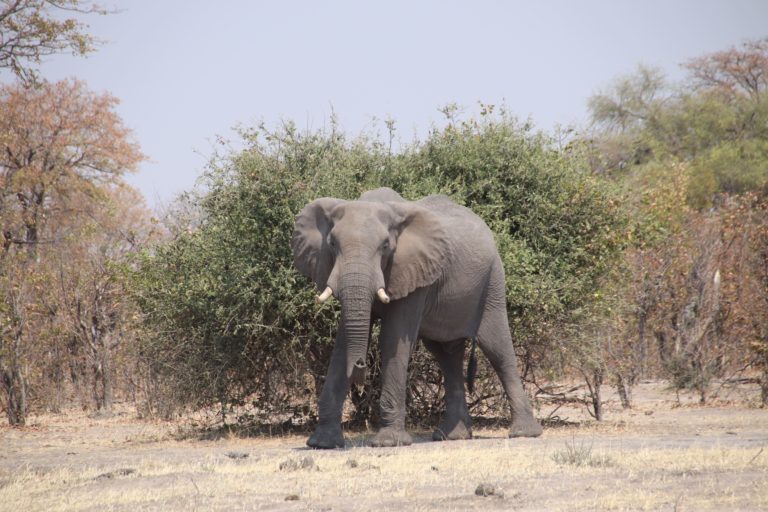
Roads: deep sand from Linyanti until Ghoha gate. Less deep sand until Savuti. Fairly good dirt tracks until Mababe gate. Even better road from Mababe gate to Khwai Development Trust.
Time: 6-7 hours
Kilometers: 160
Accommodation: unpowered campsite at Magotho camp (Khwai Development Trust)
DAY 20 – Khwai
Another awesome campsite. We got a secluded site right next to the river. There is an extensive network of game driving roads around the campground. We went for morning and evening drives both mostly just enjoyed hanging around our campsite.
Another bonus to staying at Magotho is that the campground fee is lower than the governmental campgrounds inside the National Park. And, you really don’t even need to go into the park either to game drive, so no park fees then either:)
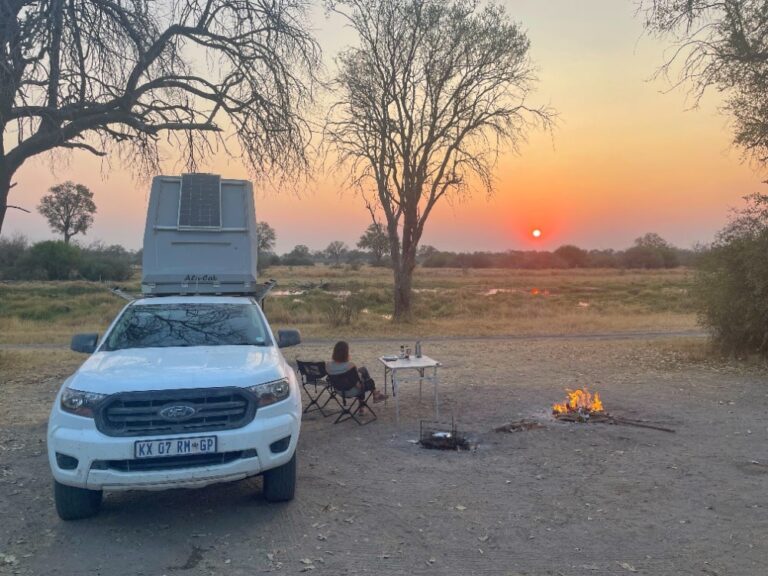
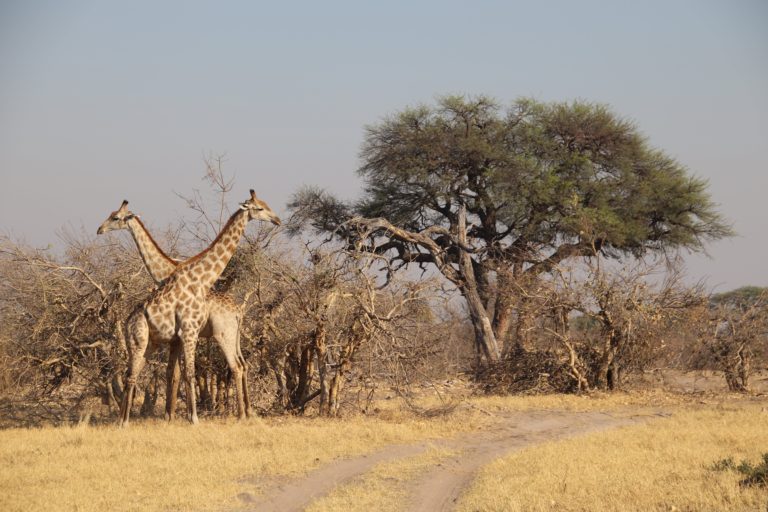
Roads: dirt track and some sandy roads.
Accommodation: unpowered campsite at Magotho camp (Khwai Development Trust)
DAY 21 – Khwai to Maun
Departed Khwai: 10 am
Arrived Maun: 2-3 pm
On our last day we went for a final nostalgic game drive and then headed to Maun. It was dirt road all the way to Mawana checkpoint. There we went through another round of tire and shoe disinfecting. The rest of the way to Maun is smoothsailing.
Roads: dirt track and sealed roads
Time: 4-5 hours
Kilometers: 140
Before you go: planning your trip
I hate to even say this, but start planning early! Especially if you’re going in the high season (June to September). We started planning 5-6 months ahead, which is extremely early for us but in fact on the late side. Campgrounds book out, in particular the government campgrounds in Botswana’s Chobe and Moremi/Okavanga Delta. We had to tweak our route a bit to work around campground availability. You have to contact the campgrounds, check availability, and plan your whole itinerary. Rental cars will also book out especially in high season.
When to go
Botswana’s dry season largely overlaps Namibia’s, with May through to October being the best time for wildlife spotting in Botswana and also the best time to travel in the Okavanga Delta.
We planned our trip to run from mid August into early September. It’s high season from June to September, which meant that campground rates were a bit higher and the car cost more. That’s winter time, too, and we thought the weather was just about perfect. It was always sunny with comfortable daytime temperatures. It definitely got chilly at night and in the early morning so bring some warm clothes to layer-up. We asked for an extra blanket for the rooftent and we slept perfectly.
Where to start and end
You’d probably start your trip in Windhoek, Johannesburg, Cape Town, Gaborone, or Maun/Kasane (Botswana). We decided to start in Johannesburg.
In the planning stage we debated if we should head from Johannesburg to Maun (Botswana) first and then to Namibia, or vice versa. Since we were travelling onwards to Zambia after the roadtrip, and also wanted the wildlife in Botswana as a highlight at the end, we decided to go west, to Namibia first. So, we went through the Kgalagadi Transfrontier Park to Namibia, and ended the trip in Maun.
For us, this was the right choice. It gave us a chance to get familiar with the car and handling it in different road conditions before really going into the bush in Botswana. We also liked the progression from Kgalagadi Transfrontier Park to Etosha National Park to the absolute safari dream highlight, Chobe (really any part of Botswana fits into the safari dream category).
How many days
We wanted to see most of the highlights in Namibia and Botswana. We also wanted some chill days after lengthy drives and to stay extra days in the parks to get the most out of our game driving. We landed on twenty-one days and it felt like a good amount of time to do what we wanted to do without rushing around.
Two nights in both Kgalagadi Transfrontier Park and Etosha was enough. We’d have spent more time in and around Chobe if more campgrounds had availability.
Camping
We hired a 4×4 with a roof tent. Super comfortable, and took literally minutes to set up or pack up camp. You could also just bring a tent and set up camp on the ground too.
We hired a car that came equipped with everything we needed for cooking, kitchen sink included. We kept the water tank on the car filled and carried charcoal for braaing as well as a gas bottle for the stove. We’re coffee lovers so our Aeropress comes with us everywhere we go. No nescafe here, thanks. We also had our manual water filter with us, plus our Crazy Cap UV filter.
We are also food-and-cooking-lovers, so we planned meals for three to four days and went grocery shopping in the bigger towns. If you’re a meat lover southern Africa is your kind of place.
When it comes to camping on this trip, we were spoiled for choice. You can have it as rough and rustic or as comfy and chill as you like. We tried all sorts of sites, from isolated no-frills bush camping to tidy little camps with open-air kitchens and showers. Sometimes there was a fence between us and the unknown, and other times…not so much. Keep in mind that at unfenced sites, you won’t be able to leave your camp after night – so go to the ablutions block before dark!
We often took powered sites with electricity but you don’t have to. If you’re going to drive all day then plugging in the car isn’t such a huge concern but in cases where we planned to chill out in the campsite we needed to keep an eye on the car battery. Many sites will have a braai – bring charcoal. Those sites will often have a tap in the site or nearby for washing water as well. Our sites in Linyanti and Khwai had nothing – we bought firewood and had our own grill etc to put on top.
It depends what you like but trying a mix of sites with different amenities (or none at all) worked really well for us.
It can be a bit tricky to book campsites, especially in Botswana. Some campgrounds are run by private operators, some by the Botswana Department of Wildlife and National Parks (DWNP). We found Ostrich trails to be a good source of information for campgrounds and contacts details in Botswana.
Our top campsites that we just loved the most were:
- Magotho. Rustic, remote.
- Linyanti. The same, plus the river’s edge setting and all the elephants in the site!
- Ngepi campground. Private, beautiful views, and I won’t lie – the woodfired outdoor bathtub.
- Etosha Trading Post. Handy to Etosha but way more atmospheric than the ones in the park.
- Brandburg White Lady Lodge. Beautiful setting, very secluded.
- Klein Aus Vista. Simple site and the lodge it belongs to has a nice terrace and pool.
Costs
Our daily budget included fuel, accommodation, car rental, and food and drinks. Then there are also things like park fees, occasional road taxes, extra things we did along the way.
- We spent around 20 USD per night on campsites in South Africa, around 28 USD per night in Namibia, and just a bit more than that for campsites in Botswana outside the parks. That’s all based on two people in a site. Inside Botswana’s National parks, expect up to 50 USD per person per night for the popular governmental sites.
- Car rental will vary by season but basically – as a ballpark figure, the best quote we got (and took) was 155 USD per day.
Other essentials
- Visas. A lot of nationalities can travel here visa-free. Check your country’s visa requirements. Make sure you declare in advance if you’re planning to take the car across borders.
- Maps.me is indispensable. In addition to the actual route, a lot of detours and good stops are marked on it as well. Many people consider it better than Tracks4Africa.
- Powerbanks. Keep a full one handy just in case.
- Flashlight. For night time bathroom trips, if nothing else. Which reminds me: toilet paper.
- Some warm clothes for the chilly nights and mornings
- Screenshot or printouts of National park and campsite bookings.
- Money. There are plenty of ATMs in any town, and you can mostly pay by card everywhere. In remote areas it is always handy to have some cash for emergency. Most of our campsites we had to fully pay in advance.
- Sim, WiFi. We had an Airolo eSim for Nambia and Botswana. That worked fine apart from in the bush and rural areas. Most campsites in Namibia have WiFi. Campsites in Chobe will most likely not have WiFi or phone signal.
- Satellite phone. We only used it for a short call to the car agency to arrange the drop off….but then again I’d prefer not to need it anyway. It was good to have ‘just in case’ and cheap anyway.
Maun, and moving on
Eventually it was time to return our home on wheels, and get back on public transport. We were headed for Zambia next, but first took a break to rest up in Maun.
We sat in a Nando’s reliving the trip over chicken dinners…at least, a break from red meat. We slept comfortably in our air-conditioned room, and started making onward plans. But there is definitely something to be said for boerewors on the braai and falling asleep in a roof-tent on a chilly night under the stars, somewhere in Africa.
Read More
Looking for some inspiration? Read this post about the things we saw and did on this roadtrip. And there’s this post, about crossing the border from Botswana to Zambia.
Or check out the Destinations page for stories about our other off-beat adventures all over Africa. For a different type of safari, you can always ride the Tazara train from Zambia to Tanzania.
For more of our adventures (and misadventures) as we travel from Cameroon to Japan, check out the rest of my stories from the road.




This Post Has 4 Comments
Very inspirational and beautifully accounted. Wishing you many more fulfilling adventures! And thank you.
Thank you, I’m glad you enjoyed it! Happy adventuring to you, too 🙂
thank you! We are thinking about a shorter verson of this mostly focused on Namibia and Botswana. This was super helpful.
You’re welcome, I’m happy it helped:) Have an amazing trip!